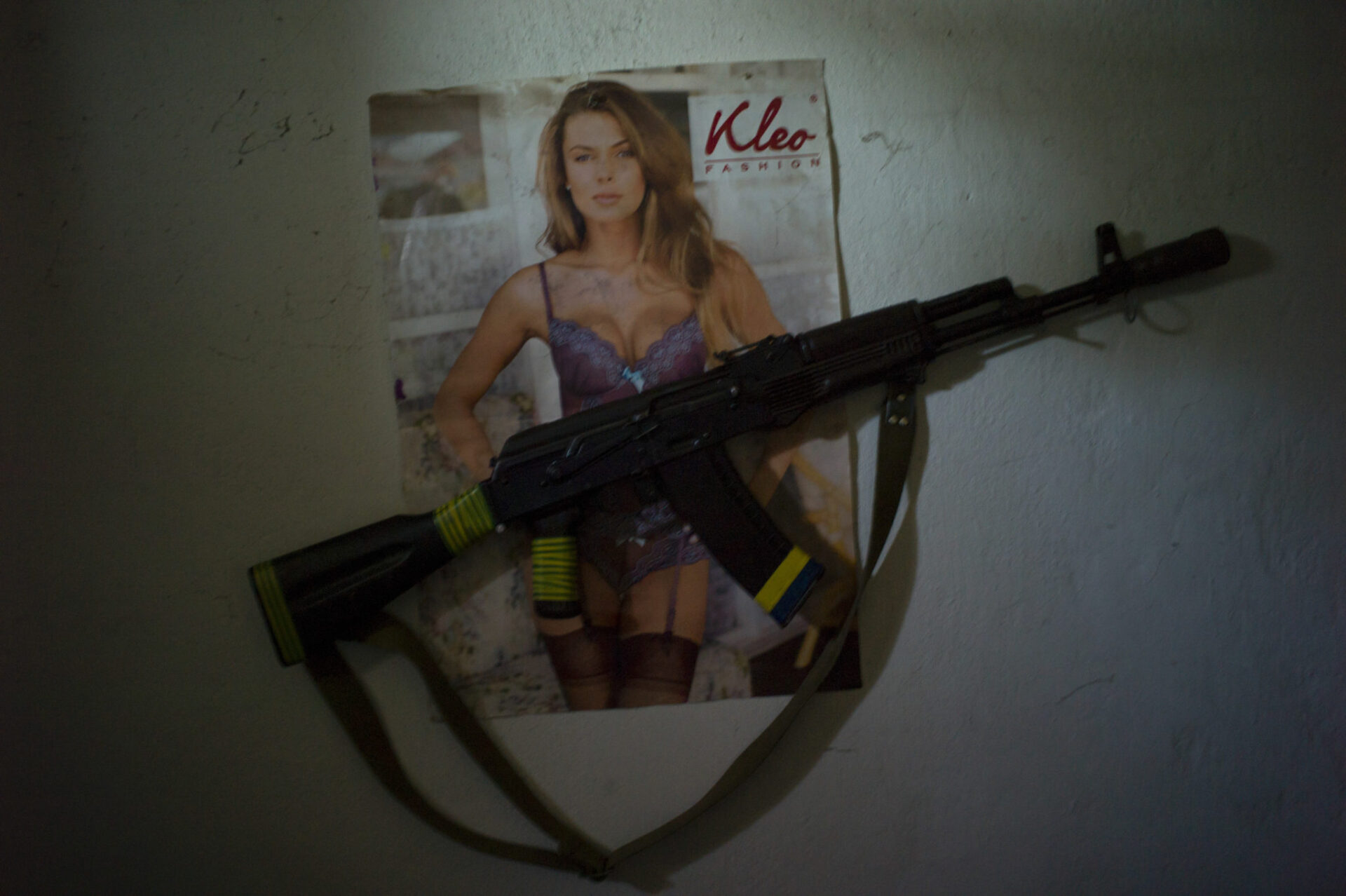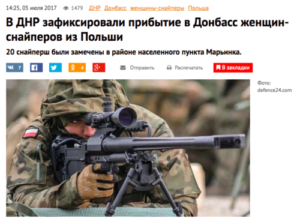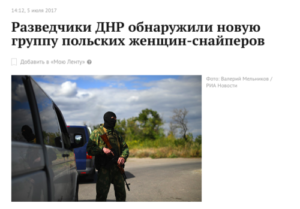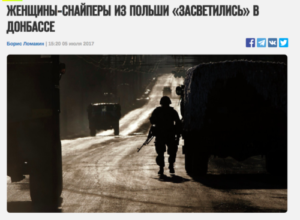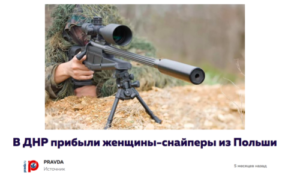Nobody knows how many women came over. What people say is that they came from Georgia, they were rude and provocative, and they were most likely snipers. Apart from Georgians, there were also Poles – probably recruited by some private company. A large group of Polish women appeared at the frontline and together with Ukrainians shot at the separatists from Donbas. That’s what Donbas separatists’ supporters say.
Information on foreign mercenaries, including Polish ones, taking part in the war in Ukraine has been published by official Russian news agencies numerous times. The comments under articles about Polish snipers in Donbas are very blunt: they are named „whores” and „prostitutes” who should be „beaten to death in the bushes and thrown into a hole”. The news about mercenaries has been also repeated by the media in EU countries, including Poland. The „mercenary problem” has become one of dozens small arguments, which are to convince the world that Western politicians and journalists are lying about Ukraine.
The only trouble is that the mercenary stories are fake. How fast they spread on the Russian-speaking Internet – and then around the globe – might actually be a better story than the tales about rude and provocative female snipers. Moreover, a true one.
The witches fight in Donbas
It was spring 2017 when the Russian media started publishing stories about Poles in Donbas more often than they used to. On March 21st 2017, the Russian press agency RIA Novosti reported that hundreds (sic!) of people had been killed by Polish mercenaries.
In June, the representatives of the Donetsk and Luhansk People’s Republics informed that several hundred mercenaries came to Donbas from Poland, Georgia, Baltic states, Canada and USA. Nobody knew how they managed to reach the frontline, although apart from small arms, they were reported to also have armored carriers and infantry fighting vehicles. Then, on July 3rd, the Luhansk People’s Republic (LPR) People’s Militia spokesman Andrey Marochko talked only about Polish hired soldiers – due to him, the Ukrainian army had placed 120 of them, working for an unknown Polish private military company, near Luhansk. Information about the mercenaries being of Polish origin came from LPR’s military intelligence. Proofs?
According to Marochko, mercenaries communicated in Polish and used Polish flags. Russian media illustrated the findings with dozens of different photos, but… none of them showed the mercenaries in question. Instead, stock photos and photos from military drills in Poland were used.
The Russian media also reported that the Polish mercenaries unit was located right next to the troops of nationalists from the Right Sector. That kind of narrative was to make Poles even more odious to the Russians and people living in the East of Ukraine.
The July news about the mercenaries – also female ones, didn’t come as a surprise. Russian propaganda has been dropping „hired army” news into the media every couple of months. Information about the alleged presence of Polish female snipers in Donbas seems to be exceptionally popular.
News about female fighters sent to Ukraine from abroad appeared in propaganda coverage for the first time a few years ago, at the beginning of the Donbas conflict. In 2017 the topic made its way back to the news – it was Andrey Marochko from LPR People’s Militia (quoted above) who first informed about the arrival of Polish female snipers. On April 9th 2017 he told the press about a large group of people who came to Donbas to fight on the Ukrainian side, consisting mostly of women from Poland, Lithuania and Latvia.
The information about female snipers was confirmed on July 5th 2017 by Eduard Basurin, deputy Commander of the Donetsk People’s Republic (DPR) Operational Command. According to information supposedly obtained by the military intelligence of DPR, a unit of 20 women employed by a private Polish company arrived to the frontline in the suburbs of Donetsk. Prior to that, a group of Georgian female snipers was to arrive to that area. According to Russian-speaking media, the women were „rude and provocative”. There was also a rumor (presented as fact by some media outlets) about the existence of a special female snipers unit called Witches, which was to be part of the Right Sector troops.
No proofs for the female snipers arriving to Donbas has been presented either. Propaganda on the matter is rather ham-fisted and makes close to no effort: the arrival of the women was illustrated in Kremlin’s media with pictures of men.
- “Women snipers from Poland arrived in Donetsk People’s Republic”, source: ren.tv
- “DPR scouts found a new group of Polish women snipers”, source: lenta.ru
- “Women snipers from Poland >surface< in DPR"; source: 360tv.ru
- “Female snipers from Poland came to DPR”, source: pravda.ru
Factory of lies
From the very beginning, the stories about the presence of Polish mercenaries in Donbas have been supported by a mass propaganda attack, conducted also by Russia-controlled internet trolls.
Russian-language websites that report on the conflict are read (and commented on) mostly by the people living in Russia and Eastern Ukraine. Those websites have a ready explanation for the Polish presence in Donbas: it’s connected to the Polish Russophobia and puppet-like Polish government, which is steered by the US.
Russian trolls also pay a lot of attention to the alleged absurdity of Poland’s cooperation “with Bandera’s Ukraine” while „Bandera followers are responsible for deaths of hundreds of thousands of Poles, including women, children and the elderly”. They share some warnings: „Ukrainians fought us in Chechnya and in Georgia so we took Crimea and Donbas. Go ahead, Poland, we’ll come for you as well!”.
The comments about Polish female snipers in Donbas are consistent: they are „whores” and „prostitutes” who should be „beaten to death in the bushes and buried somewhere”. Trolls comment in Polish as well: if the presence of „Polish snipers” in Donbas is confirmed, Russians and separatists should: „kill them”, „annihilate them”, „bomb them” or simply „put a bullet right between their eyes, no questions asked”.
In July 2017, Russian national television Russia-24 aired whole program dedicated to the presence of Polish mercenaries in Donbas and wondered why, despite such sensational news, presented broadly by Russian media, Polish authorities and media remained silent.
“Silence seems to be the best tactics for the Polish authorities. Any serious reaction would serve to feed Kremlin’s factory of lies. Propaganda should be discredited and ridiculed, and when it’s built on obvious lies – there should be no discussion”, says Andrzej Wilmowski, a Polish expert on Russian propaganda, who has been researching the alleged Polish mercenaries in Donbas for some years now.
Polish mercenaries from a non-existent company
How does propaganda explain the lack of proof for the presence of Polish hired troops in Donbas? It’s simple: it was proven long ago that there were foreign dogs of war in Ukraine. The truth is, however, that no reliable proof, supporting the claim of Polish troops taking part in this war, has ever been presented by the Russians. And rumors about it have been spreading at least from 2014.
The first signal of the alleged Polish presence in Donbas appeared soon after the Armed Forces of Ukraine started an anti-terrorist operation (ATO) in the Eastern part of the country. The source of the news was a pro-Kremlin news website, Kavkazpress. An article dated May 6th 2014 published news about dislocation of foreign private military companies in the East of Ukraine. It also informed that there were 35 Polish soldiers in Donbas, all of them hired by a private military company ASBS Othago (in Poland the case was first reported by Andrzej Wilmowski in Nowa Europa Wschodnia magazine).
What do we know about ASBS Othago? The company’s full name is Analizy Systemowe Bartłomiej Sienkiewicz „Othago”. It belonged to Bartłomiej Sienkiewicz, former Minister of Internal Affairs in PO-PSL government (February 2013 – September 2014). The company was dissolved in January 2013, a month before Sienkiewicz became the government minister and over a year before the sensational information was released by Kavkazpress.
Apart from the Polish company, there were – allegedly – also American companies Greystone and Hello Trust in Donbas, as well as Lettera-43 from Italy. The information, published by Kavkazpress in May 2014, was shared only by niche pro-Kremlin websites such as Warsonline.info, Pravda-tv.ru, and Novorossia.org.
Pro-Kremlin websites attack
However, the news of alleged presence of Polish troops in Donbas found its way also into Polish media. On May 12th a conspiracy theory website zmianynaziemi.pl (according to Similarweb, in October 2017 – over 3.7 million page views) reported: „Russian media inform that during clashes in Sloviansk, Ukrainian command was supported by Polish military forces”. Suggesting the information was true, the author of the article (singed “admin”) warned: „President Putin has already made clear that Poland might have inspired the coup in Ukraine. (…) One can’t help but notice that someone is deliberately putting Poland in great danger by pursuing irresponsible policies. (…) We can now imagine many different scenarios that could lead Poland to a military conflict with Russia. (…) As we know, Russia always seeks revenge for meddling in its business.”
In following weeks and months, information about Polish units participating in clashes in Eastern Ukraine was published on several dozen Polish-speaking websites (e.g. Monitor-polski.pl, Wolna-polska.pl or Wirtualnapolonia.com), and blogs (e.g. Marucha.wordpress.com, Michalkiewicz.pl, Wiernipolsce.wordpress.com).
The news about alleged Polish presence in Eastern Ukraine also got published by two relatively popular, nationalist and pro-Russian websites: Xportal.pl and Kresy.pl. They referred to outside sources (usually Russian media). Both undertook some security measures and asserted the information had not been confirmed. Smaller websites went as far as to almost translate Russian propaganda into Polish. The published stories were not always exactly the same, but there were a few consistencies: author’s belief in Polish engagement in the fights in Donbas and a mandatory handful of good advices (“Polish units must be withdrawn from Ukraine”; “we should not provoke Putin”).
Secret flights, CIA agents and amphetamine
The myth of Polish troops taking part in the fights in Ukraine was sealed by the self-proclaimed mayor of Sloviansk, Vyacheslav Ponomarev. On 17th of May 2014 the mayor delivered a speech, asserting that among the victims of ATO were, among others, hired militaries from an American company Academi (formerly known as Blackwater) and Greystone (66 casualties), CIA and FBI agents, and 6 members of the Polish company ASBS Othago. In the following months, those killed mercenaries from Academi, Greystone and ASBS (which no longer existed) became a symbol of the alleged engagement of Western military companies in Donbas conflict.
Thanks to the mayor of Sloviansk, the news about Polish mercenaries for the first time made its way to the mainstream Russian media, such as Russia Today. In order to help the topic circulate more broadly, the disinformation campaign included opinion-formers from other countries. On 28th May 2014, a Canadian analysis center Global Research – known for its anti-US and pro-Russian sentiments – publishes an article Polish Death Squads Fighting in Ukraine. CIA Covert Operation? The article informed that a plane had secretly arrived at Kiev’s airport in May 2014 – it was allegedly transporting not only firearms and 500 packs of amphetamine, but also members of the Right Sector, Polish fighters from ASBS Othago and a CIA agent Richard Michael.
‘It seems that the Kiev junta and its Western masters are prepared to resort to any provocations, up to and including using chemical warfare agents on the local population, as happened recently in Syria, and earlier in Iraq, where it was the Poles who specialized in such matters,’ announced Global Research.
Other sources informing about alleged presence of the Polish forces in Eastern Ukraine were Hungarian website hungarianrealnews.com, Czech pages Novarepublika.cz i Czechfreepress.cz, and Slovakian domino50.blog.pravda.sk.
As fighting in Donbas intensified, following months brought a discharge of information on alleged Polish forces in Eastern Ukraine. The series of news from 2014 was rather impressive:
In June, press services of the separatists Donetsk People’s Republic informed about taking Polish mercenaries prisoners, and elimination of 8 snipers from ASBS Othago.
In July, a brigade of soldiers from the 1 Masurian Artillery Brigade allegedly arrived to the port in Odessa, along with 12 gun-howitzers „Dana” that belong to the Polish Army.
Also in July 2014, the commander of separatist forces of DPR, Igor Strelkov, informed about eliminating 139 ASBS Othago soldiers.
In August, a pro-separatist press agency Voenkor.info informed about a trap that had supposedly destroyed a jeep with 6 Polish soldiers from ASBS Othago and one gun-howitzer „Dana” they had with them.
In September, acting Minister of State Security of DPR Leonid Baranov informed about more Polish mercenaries taken prisoners. Ruspravda.info picked up on the news. The website counted 105 Polish „dogs of war” whose goal was to lead Ukrainian army’s artillery fires towards the separatists.
The misinformation campaign, directed mainly at Russian and Ukrainian recipients, was accompanied by efforts to influence Polish audiences. On 14th September 2014, pro-Russian Ukrainian hackers from KiberBerkut attacked websites of the President of Poland and of the Polish Stock Exchange. The attack was complemented by two messages to Poles. In the first one, KiberBerkut threatened: „By interfering into another country’s business, Polish government shows no concern not only for their citizens’ affairs, but also for their lives. (…) The people [from ASBS Othago – editorial note] have blood of mothers, elderly and children on their hands. In the name of the people of Ukraine we demand immediate withdrawal of Polish mercenaries from our country’s territory.”
In the second message, KiberBerkut spoke directly to the Polish people: „Today, Ukrainian neo-Nazis are trying to replicate the events from 1943, when the Ukrainian Bandera-supporting murderers butchered over 36,000 Polish people in Volhynia … For the sake of the sacred memory of the victims of Volhynia, help us stop the genocide of South-Eastern Ukraine!”
Propaganda to the beat of war and politics
As if by magic, after signing of the Minsk Protocol in September 2014 and ceasefire in Donbas, the number of articles about Polish troops in Eastern Ukraine suddenly went down.
But in January 2015 Russians assaulted Debaltseve. On 26 January 2015 Russian president Vladimir Putin claimed publicly that he considered Ukrainian army a „foreign NATO legion that does not defend Ukraine’s national interests but has one geopolitical purpose: to block Russia”.
Sensing Putin’s intentions, Russian television REN TV sent out its reporters across Europe: to Sweden, Italy, United Kingdom and Poland. Their assignment was to locate the „NATO legion”.
One of the correspondents – Viktor Sineok – came to Warsaw, but he failed to find the legendary ASBS Othago. The old ASBS address now belonged to another institution: a consulting company Salvor. Sineok believed that Salvor’s real work revolved around recruiting soldiers to Donbas, just like ASBS Othago had done before. Any proof? „Private military companies all over the world pretend to be consulting companies only,” explained the journalist.
In February 2015, another ceasefire was signed in Donbas. The number of articles about alleged participation of foreign forces in the war in Eastern Ukraine dropped again. Every now and again, separatists complained to the media that they were being hunted by hired female snipers from Poland and Baltic states, but it seems they were just trying to keep the topic and anti-Polish sentiments alive.
Meantime in Poland, political situation changed. Bartłomiej Sienkiewicz, the Minister of Internal Affairs accused by the Russian propaganda outlets of sending Polish mercenaries to Donbas, left the political stage. Almost at the same time, in the propaganda narrative, Polish hired soldiers started to represent an „unspecified Polish military company”. This description was used by various sources, including Sputnik Poland – an outlet that is part of the Russian media holding operating internationally. Between January and June 2016, Sputnik Poland published a series of articles, three times informing about an anonymous Polish military company sending its hired forces to Donbas.
Dozens of articles on alleged foreign forces in Donbas were not followed by any proof to support this information. Remarkably, most articles were accompanied by stock or random photos. No media outlet has ever published any photos, documents or videos showing Polish mercenaries captured or killed in Donbas.
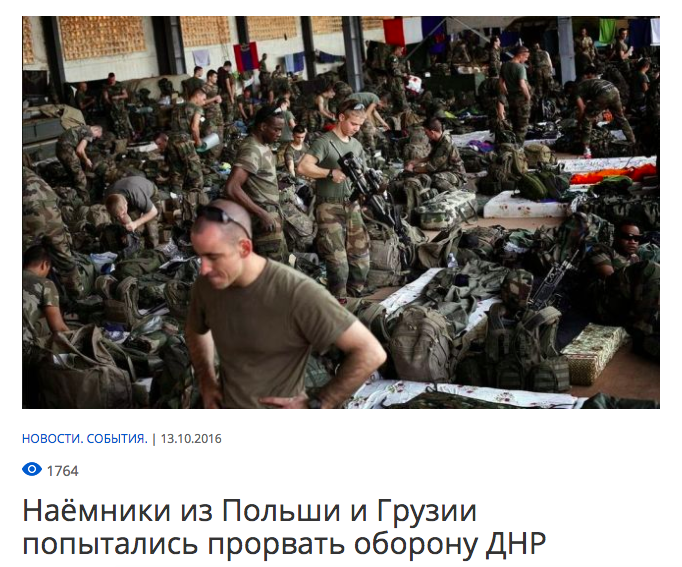
Title: “Mercenaries from Poland and Georgia tried to break through the defense of DNR” The photo shows French troops in a hangar at Bamako’s airport in Mali.
The publications about Polish hired military forces were examined by a Polish researcher, Kacper Rękawek. In his article Neither „NATO’s Foreign Legion” Nor the „Donbas International Brigades:” (Where Are All the) Foreign Fighters in Ukraine? Rękawek proved that according to the most reliable sources, there have been roughly 300 hired soldiers fighting on both sides of the conflict in Donbas (most of those being people from the former USSR states), including 16 Poles (6 mercenaries on separatist side and 10 on the Ukrainian side). Similarly low numbers of Polish fighters in Donbas are reported by trustworthy materials published by various Polish, Ukrainian and Russian journalists.
Who believes Kremlin?
In 2016, an independent public opinion research work group Yuri Levada Center published results of surveys on attitudes of Russian citizens towards various countries. Poland was deemed the fourth most hostile country towards Russia (24%). The only nations with results higher than Poland were USA, Ukraine and Turkey.
Similar research was done in Ukraine. According to the Ukrainian public opinion research centre Rating Group, the level of friendly attitudes towards Poland in Ukraine grew from 50% in March 2014 to 58% in November 2015, and declarations of hostile attitudes have dropped from 15% to 5%. Similar tendencies can be noticed in the regions most vulnerable to Russian propaganda – Eastern and Southern regions of the country, as well as Donbas.
Polish mercenaries and soldiers in Donbas are a myth. However, in order to create this myth, Russian propaganda employed a whole spectrum of resources needed to carry out an effective propaganda campaign: politicians, political analysts and political scientists who had the most popular TV and radio channels at their disposal, as well as first pages of Russian newspapers and magazines with the largest print runs, and popular websites.
Analysis of changes in levels of friendly and hostile attitudes of Russians and Ukrainians towards Poland leads to a conclusion that the strategy might be partially effective. In case of Russians, it is clear that the tendency to consider Poland an enemy grows together with intensified levels of propaganda disinformation transmitted through the media. On the other hand, a large number of Ukrainians (including those living in Eastern parts of the country) seem to have ignored negative messages about Poland.

